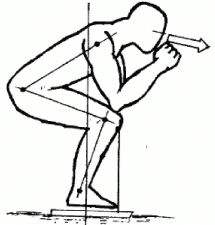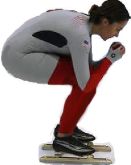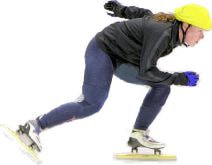Why Are The Koreans So Good?By Susan Ellis, April 2010
|
Our thoughts create our reality – where we put our focus is the direction we tend to go. ~ Peter McWilliams |
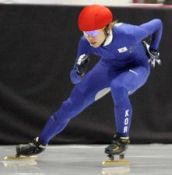
I am often asked “Why are the Koreans so good?” My simple reply is TECHNIQUE! They are taught correct technique from the time they first step on the ice and it is constantly drilled into them and reinforced. Yes, true, they also spend more time training than their European and North American counterparts, but even young Korean kids in North America, who don’t spend quite as much training time as they would in Korea understand that position is everything. While at a World Cup in Korea I had the opportunity to witness a practice for young kids. I was amazed to see rows upon rows of kids just learning basic position and then moving back and forth in that position. They all looked pretty darn good. And the coaches went up and down the rows making adjustments as necessary to make sure each kid got it. And, no, Korea does not have great numbers of skaters – about 900 compared to over 5000 in Canada.
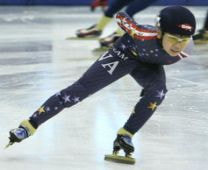
Korean kids also spend time off ice practicing the position and learning how to perform dryland drills to reinforce position, pressure, and movement. Again there is great attention paid to detail with the result being a young skater who knows and practices a great position.
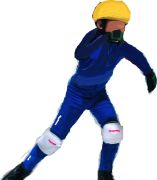
Here in North America we have perhaps a different philosophy on sport, where we participate for recreation and fun, whereas in Korea performance is important. We say, “Well, we don’t want our kids spending hours and hours training”. We tend to let the kids get on the ice and “just skate”, often with minimal attention to technique other than a coach occasionally saying get low. In a Vancouver Sun article Canadian Team veteran had this to say:
“In Korea, the way they train, it’s more like figure skating here or tennis,” said Jean. “They have private coaches. Parents pay a lot of money, and coaches for athletes at a young age are better than us in Canada, where we skate in clubs and it’s more for fun. “Kids in Korea get involved at a super young age to win. Six, seven, eight years old, the coaches put a lot of pressure on them. You can create a really good skater by 18 years old. You see them go on the ice and they trust their ability. They don’t doubt. If they want to do a move, they do it."
“In Korea, the way they train, it’s more like figure skating here or tennis,” said Jean. “They have private coaches. Parents pay a lot of money, and coaches for athletes at a young age are better than us in Canada, where we skate in clubs and it’s more for fun. “Kids in Korea get involved at a super young age to win. Six, seven, eight years old, the coaches put a lot of pressure on them. You can create a really good skater by 18 years old. You see them go on the ice and they trust their ability. They don’t doubt. If they want to do a move, they do it."
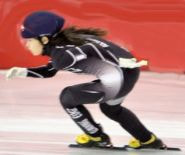
But even with our limited training time there is no reason we can’t pay more attention to the details that go into getting low, and to make it a priority for young kids to really understand the position, rather than just letting them skate laps and laps in an incorrect position. We need to rethink how the basic position is taught to young kids and it’s not just about bending the knees and putting the chest down.
|
The old method of teaching kids to get into basic, as depicted in the drawing to the left from a Level 1 manual, was to have them bend their knees, and squat, almost like sitting in a chair and place their elbows on their knees. As you can see the chest is still very high and the elbows on top of knees tends to create a very flat back with the butt sticking out. It also prevents the chest from getting any lower.
Chest positions are now much lower and the entire back is much more round, especially in the lower back to pull the hips under the body more. Notice in the above, the elbows are outside of, and below the knees, creating a rounded upper back as well. |
One of the reasons kids quit speed skating before they have a chance to really mature as a skater is a lack of success. At some point all kids realize that when you can’t keep up with the competition, whether it’s from within your own club, or from other clubs, or another province or state, then maybe there is something else out there better to do. I’m not saying this is a good thing – far from it actually! But if we can keep some kids in the sport longer because they are more competitive with their peers, then that is a good thing to strive for. My part of Canada is notorious for “Atlantic Canada Syndrome.” We can’t compete with Quebec, Ontario, British Columbia, etc. because we don’t have ….(insert a multitude of Atlantic Canadian excuses here). My thought is that Koreans don’t win simply because they are Korean, and Quebecers don’t win simply because they are from Quebec. They win because there are some solid basic principles built into their programs from the time they first start the sport. And it doesn’t matter whether the principles are taught by Asian coaches, Dutch coaches, or coaches from the great skating nation of Tahiti (hmmm, I really doubt Tahiti has an ice rink, but anyway...), the basics must constantly be introduced, reinforced, introduced again, and reinforced again, and again. And not the basics from 10 or 15 years ago; it must be new technique and new position.
I might have to disagree with Olivier a little in that I do believe we have good coaches in Canada, but our courses have not kept up with the times. I even had an athlete who attended one of my camps tell me his Level 3 coach said a good position is one with the chest up and the back fairly straight (skater to left) and that I was teaching advanced methods he didn’t need yet. I think it is likely a case of the coach not fully aware of, or understanding that things have changed over the years. Chest down is not an advanced technique, it’s simply a basic part of the skating position, as is keeping the hips tucked under. The US has had a huge influx of Korean coaches who are teaching good basics and US coaches are learning from seeing new things, whereas we haven’t had many come to Canada. So do we need to bring in Korean coaches to get better? Of course not, but we need to get in tune with newer stuff and be prepared to change our ideas on things. I don’t mean either that we need to adopt methods of training that have the kids training long hours to the exclusion of everything else. But by adding 15-30 minutes of off ice instruction to each session you can teach kids a ton about position, push, recovery, and pressure. And the bit of extra work makes them stronger and more prepared for harder training when they are ready or want to.
I might have to disagree with Olivier a little in that I do believe we have good coaches in Canada, but our courses have not kept up with the times. I even had an athlete who attended one of my camps tell me his Level 3 coach said a good position is one with the chest up and the back fairly straight (skater to left) and that I was teaching advanced methods he didn’t need yet. I think it is likely a case of the coach not fully aware of, or understanding that things have changed over the years. Chest down is not an advanced technique, it’s simply a basic part of the skating position, as is keeping the hips tucked under. The US has had a huge influx of Korean coaches who are teaching good basics and US coaches are learning from seeing new things, whereas we haven’t had many come to Canada. So do we need to bring in Korean coaches to get better? Of course not, but we need to get in tune with newer stuff and be prepared to change our ideas on things. I don’t mean either that we need to adopt methods of training that have the kids training long hours to the exclusion of everything else. But by adding 15-30 minutes of off ice instruction to each session you can teach kids a ton about position, push, recovery, and pressure. And the bit of extra work makes them stronger and more prepared for harder training when they are ready or want to.
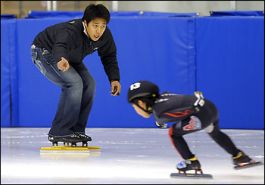
So, the Koreans are so good, especially in the long distances, because of their ability to put pressure efficiently in to the ice. OK, so why are the Canadians so fast in the 500 and not as good in the long distances? Canadians are explosive. We just get on the ice and go fast from day one. But our inefficiency shows up in the longer distances as we get tired faster than Koreans. A Korean kids practice might consist of several times 7-9 laps, but those 7 or 9 laps are done with efficiency and technique. A Canadian kids practice is either going to be a bunch of 3 lappers as we can (in incorrect positions) or a bunch of really long laps that are not done slow enough so the skater can control the technique and learn efficiency. It might sound like I’m picking on Canadians here but the same can be said for practices in the US, Germany, Great Britain, or wherever kids are practicing without attention to detail. And, no, it doesn’t have to be boring to learn technique. Be creative with your drills – it just takes imagination, and a commitment to repetition the right way. If the kids understand what the expectations are, ie: correct position, and they take off in the wrong position, you will blow the whistle and make them start again. They soon understand that focus is an important part of skating as well and they make more of an effort to skate with proper position and technique. Whether they are going to skate 3 laps fast, or 7 laps medium, or 10 long laps, have them always focus on great technique and stop them when they don’t have it.

